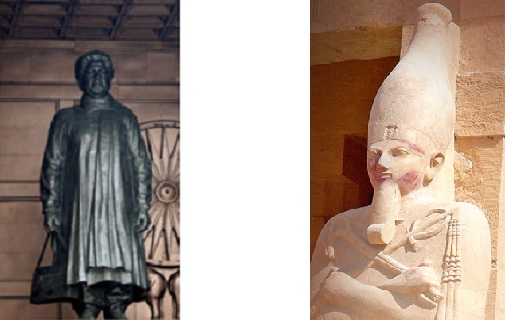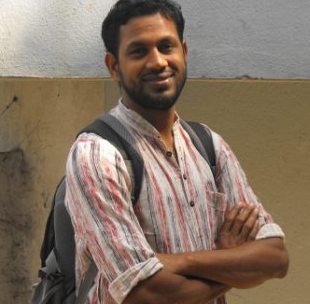A handbag. A false beard.
Two seemingly innocuous objects which transform into fearsome symbols, when they adorn the statues of Mayawati and Hatshepsut respectively. These women statues have unleashed unprecedented amounts of societal outrage. Is the cause for outrage the engravings themselves, or the depicted demeanor, or is it the act of consecrating one’s own statue? The answer would be all three reasons and more. The intensity of the backlash alludes to the kind of transgressive power that Mayawati and Hatshepsut have come to signify.

Several centuries separate these two women. One has an oppressed heritage, the other was a royal. Both aspired for, obtained and commanded power in the political arena. And both stood in opposition to known ways of handling political power. Compelling parallels can be traced in the stories of their power management, the most obvious one is that they went on to mark their uniqueness in stone, for posterity. To focus on any one aspect of their lives would be a dishonor to these two remarkable women. Here, I am contexting the reaction to their statues for a precise purpose, that is, to illustrate two forms of oppression: patriarchy and caste, and how they function in relation to woman power.
Hatshepsut is among other things, a historical marker for rupturing patriarchal supremacy, and likewise Mayawati is a contemporary marker for cracking open the mantle of caste supremacy.
Caste is a tightly woven mesh of many oppressions, including that of gender. Caste as a complex system of oppressive powers has its origin and practice located exclusively in South Asia, and it can rarely be illuminated effectively with idioms and metaphors from elsewhere. To understand how oppression operates and to contest it, the anti-caste discourse draws widely from the articulation of marginalized communities from all over the world. But it aims to look for meanings, definitions and examples from within the caste universe. Though separated by time, space and cultures, I still chose Hatshepsut because the sub-context here is iconography as a memory-making device for women’s history, and in this regard the parallel between these two women is obvious. As John Berger, the art critic said;
“It’s as though across time, images, I mean it sounds strange to say it, but images recognize each other. Or pay tribute to each other” .
I am a science researcher and my profession shelters my introverted nature. It suits the majority of scientists to not be visible as persons and allow only their work to speak. Does this mean I am limited in my appreciation of career choices that place women squarely in the public sphere and the demands thereof? Unlike science, low visibility is not part of the reward system for politicians. I am impressed that they work and deliver under high visibility; I am also curiously fascinated that they are also the chief arbiters of long term memory-making expenditure. In other words, the power to execute secular iconography (including that of science) is part of their profession’s power perks; they may ignore this aspect or dedicate energy to it.

(Ambedkar memorial park, Lucknow)
The architectural palettes of Hatshepsut and Mayawati were vast, in the latter’s case they include hospitals, memorials, highways, sports complexes, rural infrastructure and city enhancements but the elites direct their ire mainly towards the personal statues. This in turn points towards other structures; caste and patriarchy. That power should never have been in the possession of these two women can be grasped from the huge amounts of anxiety their statues produced, documented as furious words and destructive actions. The idea here is not to simply connect these two women leader’s personalities, or study the way they governed, but to examine what they both famously inspired –revulsion, mammoth anger, the collective fear and outrage of the powers they had displaced briefly, in their respective societies.
This takes us squarely to our understanding of iconography as a means of perpetuating old orders. Representation of women as markers of power, as agents of change or as knowledge producers is rarely encountered in the iconography of patriarchal societies. Do we wonder about this? How many women have challenged this primary means of long term memory-making in human history? Or should we say memory-making processes in patriarchal history!
Did other queens rule as kings before Hatshepsut? Her reign is not just a historical aberration- a sudden interruption in the succession of male Pharaohs, but it is a record of what that change could imply at the political level for the history of patriarchy. Because her rule did not simply follow the blueprint laid out by her male predecessors but sharply deviated from it. Her vision was not war and occupation, but trade and prosperity, and her legacy, societal peace and architectural magnificence. Legend goes that she effortlessly defanged patriarchy’s chief political machinery, the military. Restlessness of the elites automatically followed. Hatshepsut thus was an agent of change who deserved hatred from them, potent enough to warrant her disappearance from the evidential records of history.

(Deir el Bahri, Egypt)
Long after her reign, her story was pieced together from statues, images and inscriptions. All of them disfigured to some extent by her male successors.
Egyptian female king, Hatshepsut, died, images and inscriptions which recognized her as a king were defaced or destroyed. This began the long process of forgetting that Egypt had had a woman who ruled as a king. Female images of Hatsheput were also destroyed especially if they were connected with her power or title as king.
Yet she lives on, her memory tantalizes us with alternate possibilities of how societies may be governed under female leadership, under truly radical women leaders.
A note in the Metropolitan Museum of Art describes Hatshepsut’s statues thus:
“In her temple at Deir el-Bahri there were at least ten over-life-sized kneeling statues of Hatshepsut.”
Does one imagine that someone else built it for her, after her death? They were built during her reign. This ought to gently wake up the critics of Mayawati’s statues, and there are many learned ones -historians, feminists, opinion makers of all hues who go to town about her megalomaniac acts in stone. They have very public and frantic spiritual convulsions exclaiming ‘how can you build your own statues during your own lifetime?’ They all seem to be in a deep slumber about radical women’s histories elsewhere.
Criticism of Mayawati’s ‘blasphemous’ act of consecrating her own statues as a part of the pantheon of Dalit icons, always attempts to separate it from the singular power she alone wielded to halt one of the world’s biggest invisibilising projects- erasure of the evidence of anti-caste struggles. I must emphasize again, she alone commanded the power to give the world the iconography of the centuries old anti-caste movements. Can one imagine America without the positive iconography of the civil rights movement and its leaders? The anti-caste movement has been fighting a much older battle for human and civil rights of adivasis and dalitbhaujan for so many centuries now. It is imperative for the dominant caste elites to keep this completely hidden; the force of their need to retain the caste order far outweighs all the oppressive power of white America’s racism. Now, Mayawati’s architectural investments have blown the cover for good. A simple logic visually unfolds itself to the world; to acknowledge the anti-caste movements and its leaders is to acknowledge caste. To vilify the person who took up this massive corrective to historical misrepresentation is but natural. Those monuments, those statues are not just the heritage of the anti-caste movements, but they are in fact an exposition of India’s moral, political and spiritual pretensions of being a democratic, secular nation with a glorious past. It sculpts for the world– caste. It delineates in tangible form the caste history of India. When the struggle against caste is cast in stone, caste can no longer be a vaguely explained abstraction to be restricted to little academic books and exclusive conferences. Caste is now on the physical landscape, forcing national and international conversations about how India functions as a society. It informs one and all that the basic element of human interaction of people in the subcontinent is the complete and abiding faith in the inequality of humans. Racism is a term that is extremely inadequate to describe this form of human behavior.
The budget for the monuments in Uttar Pradesh went through the usual procedures of obtaining approval from the cabinet. If people in U.P thought it was an outrageous, unwarranted expense it could have triggered mass protests on the streets, it was not a project that happened in a clandestine manner, it was out there for public scrutiny at all stages. Dalit intellectuals and writers have ripped apart the false concern about misuse of public money– they simply want to know who foots the bill for all the iconography of the political leaders and movements of the dominant castes? The basic fact is that the BSP’s monument building projects could have been stopped at any time, if it had violated any known law.
So who is outraged? The brahmanical elites with access to TV studios and mainstream media. The same ones who are gleeful about public money being squandered on ephemeral mega shows like the commonwealth games.
Then what is their outrage about? Is it directed against gender or is it against caste?
How much of this overlaps with the outrage meted out to Hatshepsut’s reign and statues and how much of it overlaps with the need to continue the invisiblizing of the anti-caste struggles? What does it tell us about how caste, patriarchy and class operate?
The outcry from the elites is to hanker after Mayawati’s statues like it is a single mutation that needs quick elimination to restore us back to a world of infinitely powerless dalit men and women.
They seem to say: She is a dalit woman, she ought to reveal and bear the burden of the material deprivation of the most disempowered person, at all times, even if the ‘miracle of democracy’ elected her as the chief minister of a state as big as a country like Brazil. Her place has to be shown.
The ‘war of words’ of the elite in the media is typical of the method by which brahmanism or caste is kept alive and functional from the very top of the caste order. They will not wield the sledgehammers themselves. Vandalism will surely happen in the not too distant future. This will be followed by theorization from the same elite’s brethren in the academia about lower castes vs. dalits which results in the destruction of anti-caste monuments in U.P.
This outrage is not only the moral high-ground occupied by the elites but is in fact the fearful acknowledgment that not so often in human history do we come across a woman with the power to command the engraving of her own image in stone, which has the approval of an elected government. Here is a dalit woman who did just that. Unlike most of the female statues scattered around the world, from past to present times, neither are her statues tailored to the male gaze nor are they signposts of male benevolence, these represent her sense of history and were built to her own specifications. So there! Go on, bring in the sledgehammers.
But just pause to think about what it is that one would like to deface and destroy, the woman or her caste?
~~~~
Please read the next part of this article here.
Sources: 1) Women Rulers Throughout the Ages, Guida Myrl jackson-Laufer
2) Twice born riot against democracy, Gail Omvedt.
3) Inscription at Rashtriya Dalit Prerna Sthal
Images courtesy of Bhanu Pratap Singh and the Internet.
Anu Ramdas is a computational biologist and a volunteer at Roundtable India and Savari.









